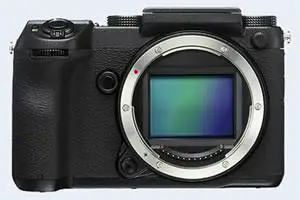Fujifilm GFX 50S vs YI M1
The Fujifilm GFX 50S and the YI M1 are two digital cameras that were officially introduced in September 2016. Both the GFX 50S and the M1 are mirrorless interchangeable lens cameras that are based on a medium format (GFX 50S) and a Four Thirds (M1) sensor. The Fujifilm has a resolution of 51.1 megapixels, whereas the YI provides 20.2 MP.
Below is an overview of the main specs of the two cameras as a starting point for the comparison.

Check GFX 50S offers at
ebay.com

Check M1 offers at
ebay.com
Going beyond this snapshot of core features and characteristics, what are the differences between the Fujifilm GFX 50S and the YI M1? Which one should you buy? Read on to find out how these two cameras compare with respect to their body size, their imaging sensors, their shooting features, their input-output connections, and their reception by expert reviewers.
Body comparison
The side-by-side display below illustrates the physical size and weight of the Fujifilm GFX 50S and the YI M1. The two cameras are presented according to their relative size. Three consecutive views from the front, the top, and the rear side are shown. All width, height and depth dimensions are rounded to the nearest millimeter.
The M1 can be obtained in two different colors (black, silver), while the GFX 50S is only available in black.
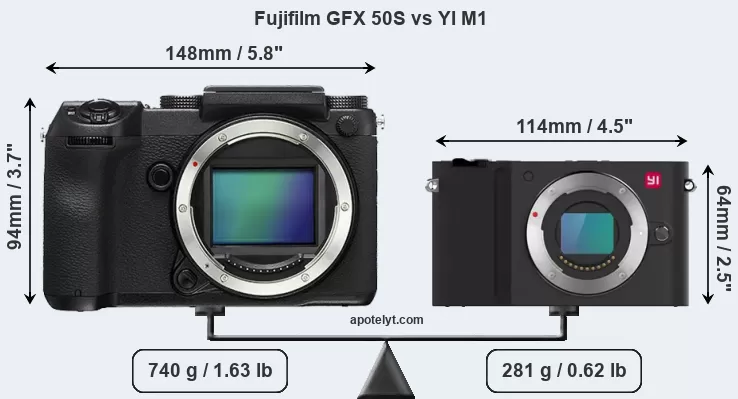
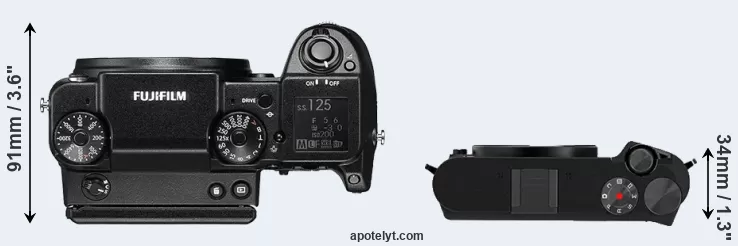
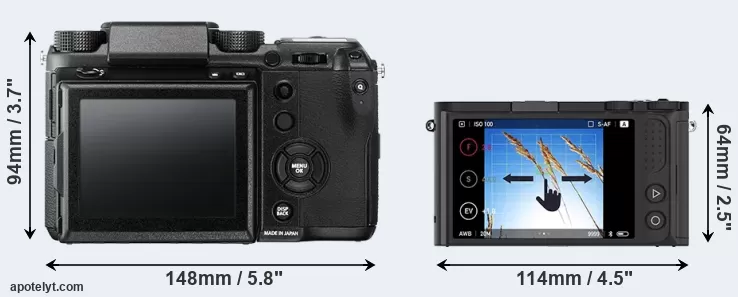
If the front view area (width x height) of the cameras is taken as an aggregate measure of their size, the YI M1 is considerably smaller (48 percent) than the Fujifilm GFX 50S. Moreover, the M1 is substantially lighter (62 percent) than the GFX 50S. It is worth mentioning in this context that the GFX 50S is splash and dust resistant, while the M1 does not feature any corresponding weather-sealing.
The above size and weight comparisons are to some extent incomplete since they do not consider the interchangeable lenses that both of these cameras require. Hence, you might want to study and compare the specifications of available lenses in order to get the full picture of the size and weight of the two camera systems.
Concerning battery life, the GFX 50S gets 400 shots out of its Fujifilm NP-T125 battery, while the M1 can take 450 images on a single charge of its YI BXM-10 power pack. The power pack in the M1 can be charged via the USB port, which can be very convenient when travelling.
The adjacent table lists the principal physical characteristics of the two cameras alongside a wider set of alternatives. If you would like to visualize and compare a different camera combination, you can navigate to the CAM-parator app and make your selection from a broad list of cameras there.

| Camera Model |
Camera Width |
Camera Height |
Camera Depth |
Camera Weight |
Battery Life |
Weather Sealing |
Camera Launch |
Launch Price (USD) |
Street Price |
||
|---|---|---|---|---|---|---|---|---|---|---|---|
| 1. | Fujifilm GFX 50S | 148 mm | 94 mm | 91 mm | 740 g | 400 | Y | Sep 2016 | 6,499 | ebay.com | |
| 2. | YI M1 | 114 mm | 64 mm | 34 mm | 281 g | 450 | n | Sep 2016 | 349 | ebay.com | |
| 3. | Canon 5D Mark IV | 151 mm | 116 mm | 76 mm | 890 g | 900 | Y | Aug 2016 | 3,499 | amazon.com | |
| 4. | Canon SX730 | 110 mm | 64 mm | 40 mm | 300 g | 250 | n | Apr 2017 | 399 | ebay.com | |
| 5. | Fujifilm GFX 50R | 161 mm | 97 mm | 66 mm | 775 g | 400 | Y | Sep 2018 | 4,499 | ebay.com | |
| 6. | Fujifilm GFX 50S II | 150 mm | 104 mm | 87 mm | 900 g | 440 | Y | Sep 2021 | 3,999 | amazon.com | |
| 7. | Fujifilm GFX 100 II | 152 mm | 117 mm | 99 mm | 1030 g | 540 | Y | Sep 2023 | 7,499 | amazon.com | |
| 8. | Fujifilm GFX 100S | 150 mm | 104 mm | 87 mm | 900 g | 460 | Y | Jan 2021 | 5,999 | amazon.com | |
| 9. | Fujifilm X-A3 | 117 mm | 67 mm | 40 mm | 339 g | 410 | n | Aug 2016 | 399 | ebay.com | |
| 10. | Hasselblad X1D | 150 mm | 98 mm | 71 mm | 725 g | .. | Y | Jun 2016 | 8,995 | ebay.com | |
| 11. | Hasselblad X1D II | 148 mm | 97 mm | 70 mm | 766 g | .. | Y | Jun 2019 | 5,750 | ebay.com | |
| 12. | Leica M10 | 139 mm | 80 mm | 39 mm | 660 g | 210 | Y | Jan 2017 | 6,595 | ebay.com | |
| 13. | Leica Q3 | 130 mm | 80 mm | 93 mm | 743 g | 350 | Y | May 2023 | 5,995 | amazon.com | |
| 14. | Leica SL | 147 mm | 104 mm | 39 mm | 847 g | 400 | Y | Oct 2015 | 7,450 | ebay.com | |
| 15. | Nikon 1 J5 | 98 mm | 60 mm | 32 mm | 231 g | 250 | n | Apr 2015 | 399 | ebay.com | |
| 16. | Panasonic GF7 | 107 mm | 65 mm | 33 mm | 266 g | 230 | n | Jan 2015 | 499 | ebay.com | |
| 17. | Panasonic GX850 | 107 mm | 65 mm | 33 mm | 269 g | 210 | n | Jan 2017 | 549 | ebay.com | |
| Note: Measurements and pricing do not include easily detachable parts, such as add-on or interchangeable lenses or optional viewfinders. | |||||||||||
The price is, of course, an important factor in any camera decision. The retail prices at the time of the camera’s release place the model in the market relative to other models in the producer’s line-up and the competition. The M1 was launched at a markedly lower price (by 95 percent) than the GFX 50S, which puts it into a different market segment. Normally, street prices remain initially close to the MSRP, but after a couple of months, the first discounts appear. Later in the product cycle and, in particular, when the replacement model is about to appear, further discounting and stock clearance sales often push the camera price considerably down.
Sensor comparison
The size of the imaging sensor is a crucial determinant of image quality. All other things equal, a large sensor will have larger individual pixel-units that offer better low-light sensitivity, wider dynamic range, and richer color-depth than smaller pixels in a sensor of the same technological generation. Moreover, a large sensor camera will give the photographer more control over depth-of-field in the image and, thus, the ability to better isolate a subject from the background. On the downside, larger sensors tend to be associated with larger, more expensive camera bodies and lenses.
Of the two cameras under consideration, the Fujifilm GFX 50S features a medium format sensor and the YI M1 a Four Thirds sensor. The sensor area in the M1 is 85 percent smaller. As a result of these sensor size differences, the cameras have a format factor of, respectively, 0.79 and 2.0. Both cameras feature a native aspect ratio (sensor width to sensor height) of 4:3.
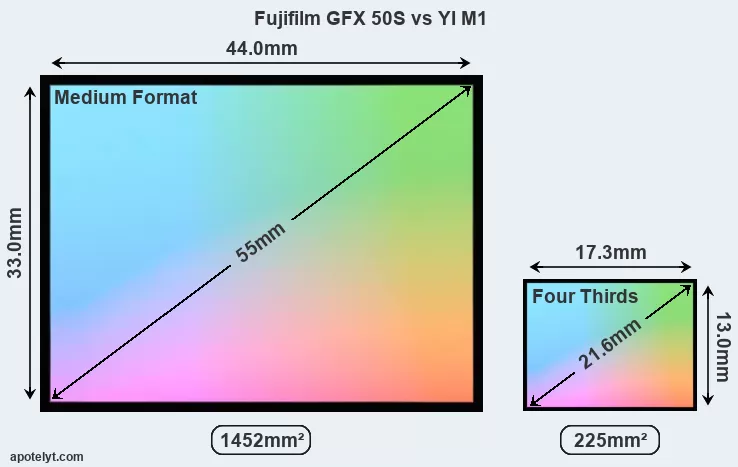
With 51.1MP, the GFX 50S offers a higher resolution than the M1 (20.2MP), but the GFX 50S nevertheless has larger individual pixels (pixel pitch of 5.33μm versus 3.34μm for the M1) due to its larger sensor. It is noteworthy in this context that the two cameras were released in close succession, so that their sensors are from the same technological generation. Coming back to sensor resolution, it should be mentioned that the GFX 50S has no anti-alias filter installed, so that it can capture all the detail its sensor resolves.
The resolution advantage of the Fujifilm GFX 50S implies greater flexibility for cropping images or the possibility to print larger pictures. The maximum print size of the GFX 50S for good quality output (200 dots per inch) amounts to 41.3 x 31 inches or 104.9 x 78.6 cm, for very good quality (250 dpi) 33 x 24.8 inches or 83.9 x 62.9 cm, and for excellent quality (300 dpi) 27.5 x 20.6 inches or 69.9 x 52.4 cm. The corresponding values for the YI M1 are 25.9 x 19.4 inches or 65.8 x 49.4 cm for good quality, 20.7 x 15.6 inches or 52.7 x 39.5 cm for very good quality, and 17.3 x 13 inches or 43.9 x 32.9 cm for excellent quality prints.
The Fujifilm GFX 50S has a native sensitivity range from ISO 100 to ISO 12800, which can be extended to ISO 50-102400. The corresponding ISO settings for the YI M1 are ISO 100 to ISO 25600 (no boost).
Technology-wise, both cameras are equipped with CMOS (Complementary Metal–Oxide–Semiconductor) sensors. Both cameras use a Bayer filter for capturing RGB colors on a square grid of photosensors. This arrangement is found in most digital cameras.
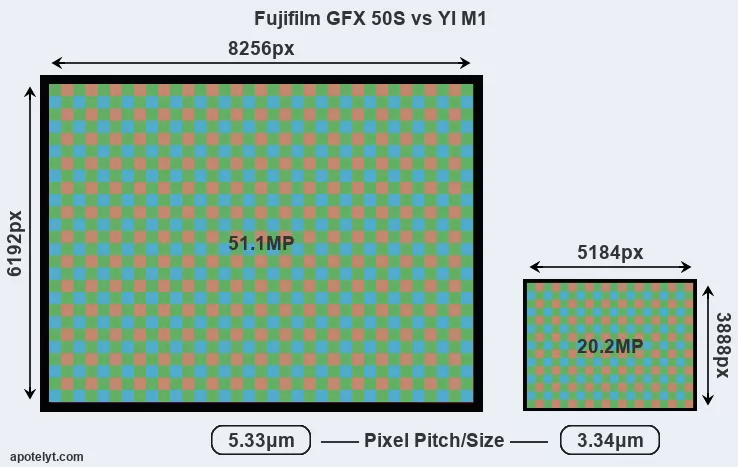
For many cameras, data on sensor performance has been reported by DXO Mark. This service determines an overall sensor rating, as well as sub-scores for low-light sensitivity ("DXO Sports"), dynamic range ("DXO Landscape"), and color depth ("DXO Portrait"). The table below summarizes the physical sensor characteristics and sensor quality findings and compares them across a set of similar cameras.

| Camera Model |
Sensor Class |
Resolution (MP) |
Horiz. Pixels |
Vert. Pixels |
Video Format |
DXO Portrait |
DXO Landscape |
DXO Sports |
DXO Overall |
||
|---|---|---|---|---|---|---|---|---|---|---|---|
| 1. | Fujifilm GFX 50S | Medium Format | 51.1 | 8256 | 6192 | 1080/30p | 25.4 | 14.1 | 2977 | 96 | |
| 2. | YI M1 | Four Thirds | 20.2 | 5184 | 3888 | 4K/30p | 23.0 | 12.6 | 1030 | 73 | |
| 3. | Canon 5D Mark IV | Full Frame | 30.1 | 6720 | 4480 | 4K/30p | 24.8 | 13.6 | 2995 | 91 | |
| 4. | Canon SX730 | 1/2.3 | 20.2 | 5184 | 3888 | 1080/60p | 20.5 | 11.9 | 924 | 50 | |
| 5. | Fujifilm GFX 50R | Medium Format | 51.1 | 8256 | 6192 | 1080/30p | 25.7 | 14.4 | 3169 | 98 | |
| 6. | Fujifilm GFX 50S II | Medium Format | 51.1 | 8256 | 6192 | 1080/30p | 25.9 | 14.8 | 3456 | 100 | |
| 7. | Fujifilm GFX 100 II | Medium Format | 101.8 | 11648 | 8736 | 8K/30p | 25.9 | 15.0 | 3651 | 101 | |
| 8. | Fujifilm GFX 100S | Medium Format | 101.8 | 11648 | 8736 | 4K/30p | 25.8 | 14.7 | 3391 | 100 | |
| 9. | Fujifilm X-A3 | APS-C | 24.0 | 6000 | 4000 | 1080/60p | 23.8 | 13.1 | 1664 | 81 | |
| 10. | Hasselblad X1D | Medium Format | 51.3 | 8272 | 6200 | 1080/25p | 26.2 | 14.8 | 4489 | 102 | |
| 11. | Hasselblad X1D II | Medium Format | 51.3 | 8272 | 6200 | 1080/25p | 25.7 | 14.5 | 3234 | 99 | |
| 12. | Leica M10 | Full Frame | 23.8 | 5952 | 3992 | none | 24.4 | 13.2 | 2133 | 86 | |
| 13. | Leica Q3 | Full Frame | 60.3 | 9528 | 6328 | 8K/30p | 25.4 | 14.7 | 3216 | 96 | |
| 14. | Leica SL | Full Frame | 24.0 | 6000 | 4000 | 4K/30p | 25.0 | 13.4 | 1821 | 88 | |
| 15. | Nikon 1 J5 | 1-inch | 20.7 | 5568 | 3712 | 4K/15p | 21.1 | 12.0 | 479 | 65 | |
| 16. | Panasonic GF7 | Four Thirds | 15.8 | 4592 | 3448 | 1080/60p | 22.7 | 12.3 | 874 | 70 | |
| 17. | Panasonic GX850 | Four Thirds | 15.8 | 4592 | 3448 | 4K/30p | 23.2 | 13.3 | 586 | 73 | |
| Note: DXO values in italics represent estimates based on sensor size and age. | |||||||||||
Many modern cameras are not only capable of taking still images, but also of capturing video footage. The two cameras under consideration both have sensors whose read-out speed is fast enough to capture moving pictures, but the M1 provides a better video resolution than the GFX 50S. It can shoot movie footage at 4K/30p, while the Fujifilm is limited to 1080/30p.
Feature comparison
Apart from body and sensor, cameras can and do differ across a range of features. The GFX 50S and the M1 are similar in the sense that neither of the two has a viewfinder. The images are, thus, framed using live view on the rear LCD. That said, the GFX 50S can be equipped with an optional viewfinder – the EVF-TL1. The adjacent table lists some of the other core features of the Fujifilm GFX 50S and YI M1 along with similar information for a selection of comparators.

| Camera Model |
Viewfinder (Type or 000 dots) |
Control Panel (yes/no) |
LCD Specifications (inch/000 dots) |
LCD Attach- ment |
Touch Screen (yes/no) |
Max Shutter Speed * |
Max Shutter Flaps * |
Built-in Flash (yes/no) |
Built-in Image Stab |
||
|---|---|---|---|---|---|---|---|---|---|---|---|
| 1. | Fujifilm GFX 50S | optional | Y | 3.2 / 2360 | full-flex | Y | 1/4000s | 3.0/s | n | n | |
| 2. | YI M1 | none | n | 3.0 / 1040 | fixed | Y | 1/4000s | 5.0/s | n | n | |
| 3. | Canon 5D Mark IV | optical | Y | 3.2 / 1620 | fixed | Y | 1/8000s | 7.0/s | n | n | |
| 4. | Canon SX730 | none | n | 3.0 / 922 | tilting | n | 1/3200s | 5.9/s | Y | Y | |
| 5. | Fujifilm GFX 50R | 3690 | n | 3.2 / 2360 | tilting | Y | 1/4000s | 3.0/s | n | n | |
| 6. | Fujifilm GFX 50S II | 3690 | Y | 3.2 / 2360 | full-flex | Y | 1/4000s | 3.0/s | n | Y | |
| 7. | Fujifilm GFX 100 II | 9440 | Y | 3.2 / 2360 | full-flex | Y | 1/4000s | 8.0/s | n | Y | |
| 8. | Fujifilm GFX 100S | 3690 | Y | 3.2 / 2360 | full-flex | Y | 1/4000s | 5.0/s | n | Y | |
| 9. | Fujifilm X-A3 | none | n | 3.0 / 1040 | tilting | Y | 1/4000s | 6.0/s | Y | n | |
| 10. | Hasselblad X1D | 2360 | n | 3.0 / 920 | fixed | Y | 1/2000s | 2.3/s | n | n | |
| 11. | Hasselblad X1D II | 3690 | n | 3.6 / 2360 | fixed | Y | 1/2000s | 2.7/s | n | n | |
| 12. | Leica M10 | optical | n | 3.0 / 1037 | fixed | n | 1/4000s | 5.0/s | n | n | |
| 13. | Leica Q3 | 5760 | n | 3.0 / 1840 | tilting | Y | 1/2000s | 15.0/s | n | Y | |
| 14. | Leica SL | 4400 | Y | 3.0 / 1040 | fixed | Y | 1/8000s | 11.0/s | n | n | |
| 15. | Nikon 1 J5 | none | n | 3.0 / 1037 | tilting | Y | 1/4000s | 60.0/s | Y | n | |
| 16. | Panasonic GF7 | none | n | 3.0 / 1040 | tilting | Y | 1/500s | 5.8/s | Y | n | |
| 17. | Panasonic GX850 | none | n | 3.0 / 1040 | tilting | Y | 1/500s | 10.0/s | Y | n | |
| Note: *) Information refers to the mechanical shutter, unless the camera only has an electronic one. | |||||||||||
One feature that is present on the GFX 50S, but is missing on the M1 is a top-level LCD. While being, of course, smaller than the rear screen, the control panel conveys some of the essential shooting information and can be convenient for quick and easy settings verification.
The reported shutter speed information refers to the use of the mechanical shutter. Yet, some cameras only have an electronic shutter, while others have an electronic shutter in addition to a mechanical one. In fact, the GFX 50S is one of those camera that have an additional electronic shutter, which makes completely silent shooting possible. However, this mode is less suitable for photographing moving objects (risk of rolling shutter) or shooting under artificial light sources (risk of flickering).
The Fujifilm GFX 50S and the YI M1 both have an intervalometer built-in. This enables the photographer to capture time lapse sequences, such as flower blooming, a sunset or moon rise, without purchasing an external camera trigger and related software.
Concerning the storage of imaging data, both the GFX 50S and the M1 write their files to SDXC cards. The GFX 50S features dual card slots, which can be very useful in case a memory card fails. In contrast, the M1 only has one slot. The GFX 50S supports UHS-II cards (on both slots), while the M1 cannot take advantage of Ultra High Speed SD cards.
Connectivity comparison
For some imaging applications, the extent to which a camera can communicate with its environment can be an important aspect in the camera decision process. The table below provides an overview of the connectivity of the Fujifilm GFX 50S and YI M1 and, in particular, the interfaces the cameras (and selected comparators) provide for accessory control and data transfer.

| Camera Model |
Hotshoe Port |
Internal Mic / Speaker |
Microphone Port |
Headphone Port |
HDMI Port |
USB Port |
WiFi Support |
NFC Support |
Bluetooth Support |
||
|---|---|---|---|---|---|---|---|---|---|---|---|
| 1. | Fujifilm GFX 50S | Y | stereo / mono | Y | Y | micro | 3.0 | Y | - | - | |
| 2. | YI M1 | Y | stereo / mono | - | - | micro | 2.0 | Y | - | Y | |
| 3. | Canon 5D Mark IV | Y | mono / mono | Y | Y | mini | 3.0 | Y | Y | - | |
| 4. | Canon SX730 | - | stereo / mono | - | - | micro | 2.0 | Y | Y | Y | |
| 5. | Fujifilm GFX 50R | Y | stereo / mono | Y | Y | micro | 3.0 | Y | - | Y | |
| 6. | Fujifilm GFX 50S II | Y | stereo / mono | Y | Y | micro | 3.2 | Y | - | - | |
| 7. | Fujifilm GFX 100 II | Y | stereo / mono | Y | Y | full | 3.2 | Y | - | Y | |
| 8. | Fujifilm GFX 100S | Y | stereo / mono | Y | Y | micro | 3.2 | Y | - | Y | |
| 9. | Fujifilm X-A3 | Y | stereo / mono | - | - | micro | 2.0 | Y | - | - | |
| 10. | Hasselblad X1D | Y | stereo / mono | Y | Y | mini | 3.0 | Y | - | - | |
| 11. | Hasselblad X1D II | Y | stereo / mono | Y | Y | - | 3.0 | Y | - | - | |
| 12. | Leica M10 | Y | - / - | - | - | - | - | Y | - | - | |
| 13. | Leica Q3 | Y | stereo / mono | - | - | micro | 3.1 | Y | - | Y | |
| 14. | Leica SL | Y | stereo / mono | Y | Y | full | 3.0 | Y | - | - | |
| 15. | Nikon 1 J5 | - | stereo / mono | - | - | micro | 2.0 | Y | Y | - | |
| 16. | Panasonic GF7 | - | stereo / mono | - | - | micro | 2.0 | Y | Y | - | |
| 17. | Panasonic GX850 | - | stereo / mono | - | - | micro | 2.0 | Y | - | - |
It is notable that the GFX 50S has a microphone port, which is missing on the M1. Such an external microphone input can help to substantially improve the quality of audio recordings when a good external microphone is used.
Studio photographers will appreciate that the Fujifilm GFX 50S (unlike the M1) features a PC Sync socket, so that professional strobe lights can be controlled by the camera.
Both the GFX 50S and the M1 have been discontinued, but can regularly be found used on ebay. The GFX 50S was replaced by the Fujifilm GFX 50S II, while the M1 does not have a direct successor. Further information on the features and operation of the GFX 50S and M1 can be found, respectively, in the Fujifilm GFX 50S Manual (free pdf) or the online YI M1 Manual.
Review summary
So how do things add up? Is there a clear favorite between the Fujifilm GFX 50S and the YI M1? Which camera is better? A synthesis of the relative strong points of each of the models is listed below.

Advantages of the Fujifilm GFX 50S:
- More detail: Offers more megapixels (51.1 vs 20.2MP) with a 59% higher linear resolution.
- Maximized detail: Lacks an anti-alias filter to exploit the sensor's full resolution potential.
- Better image quality: Features bigger pixels on a larger sensor for higher quality imaging.
- Richer colors: The pixel size advantage translates into images with better, more accurate colors.
- More dynamic range: Larger pixels capture a wider spectrum of light and dark details.
- Better low-light sensitivity: Larger pixels means good image quality even under poor lighting.
- Better sound: Can connect to an external microphone for higher quality sound recording.
- Better sound control: Has a headphone port that enables audio monitoring while recording.
- More framing options: Can be equipped with a hotshoe-mounted accessory-viewfinder.
- Easier setting verification: Features an LCD display on top to control shooting parameters.
- Larger screen: Has a bigger rear LCD (3.2" vs 3.0") for image review and settings control.
- More detailed LCD: Has a higher resolution rear screen (2360k vs 1040k dots).
- More flexible LCD: Has a full-flex screen for odd-angle shots in portrait or landscape orientation.
- Less disturbing: Has an electronic shutter option for completely silent shooting.
- Better sealing: Is weather sealed to enable shooting in dusty or wet environments.
- Faster data transfer: Supports a more advanced USB protocol (3.0 vs 2.0).
- Better studio light control: Has a PC Sync socket to connect to professional strobe lights.
- Greater peace of mind: Features a second card slot as a backup in case of memory card failure.
- Faster buffer clearing: Supports Ultra High Speed (UHS-II) SDXC cards on both slots.

Arguments in favor of the YI M1:
- Better moiré control: Has an anti-alias filter to avoid artificial patterns to appear in images.
- Better video: Provides higher definition movie capture (4K/30p vs 1080/30p).
- Faster burst: Shoots at higher frequency (5 vs 3 flaps/sec) to capture the decisive moment.
- More compact: Is smaller (114x64mm vs 148x94mm) and will fit more readily into a bag.
- Less heavy: Has a lower weight (by 459g or 62 percent) and is thus easier to take along.
- Longer lasting: Gets more shots (450 versus 400) out of a single battery charge.
- Easier travel charging: Can be conveniently charged via its USB port.
- Easier wireless transfer: Supports Bluetooth for image sharing without cables.
- More affordable: Was introduced into a lower priced category (95 percent cheaper at launch).
If the count of relative strengths (bullet points above) is taken as a measure, the GFX 50S is the clear winner of the match-up (19 : 9 points). However, the pertinence of the various camera strengths will differ across photographers, so that you might want to weigh individual camera traits according to their importance for your own imaging needs before making a camera decision. A professional wildlife photographer will view the differences between cameras in a way that diverges from the perspective of a family photog, and a person interested in architecture has distinct needs from a sports shooter. Hence, the decision which camera is best and worth buying is often a very personal one.
How about other alternatives? Do the specifications of the Fujifilm GFX 50S and the YI M1 place the cameras among the top in their class? Find out in the latest Best Mirrorless Interchangeable Lens Camera listing whether the two cameras rank among the cream of the crop.
In any case, while the comparison of technical specifications can provide a useful overview of the capabilities of different cameras, it says little about, for example, the shooting experience and imaging performance of the GFX 50S and the M1 in practical situations. User reviews that are available, for instance, at amazon can sometimes shed light on these issues, but such feedback is all too often partial, inconsistent, and inaccurate.
Expert reviews
This is where reviews by experts come in. The following table reports the overall ratings of the cameras as published by some of the major camera review sites (amateurphotographer [AP], cameralabs [CL], digitalcameraworld [DCW], dpreview [DPR], ephotozine [EPZ], photographyblog [PB]). As can be seen, the professional reviewers agree in many cases on the quality of different cameras, but sometimes their assessments diverge, reinforcing the earlier point that a camera decision is often a very personal choice.

| Camera Model |
AP score |
CL score |
DCW score |
DPR score |
EPZ score |
PB score |
Camera Launch |
Launch Price (USD) |
Street Price |
||
|---|---|---|---|---|---|---|---|---|---|---|---|
| 1. | Fujifilm GFX 50S | .. | .. | 4.5/5 | 85/100 | 5/5 | 4.5/5 | Sep 2016 | 6,499 | ebay.com | |
| 2. | YI M1 | .. | .. | .. | 69/100 | .. | .. | Sep 2016 | 349 | ebay.com | |
| 3. | Canon 5D Mark IV | 4.5/5 | + + | 4/5 | 87/100 | 4.5/5 | 4.5/5 | Aug 2016 | 3,499 | amazon.com | |
| 4. | Canon SX730 | .. | + | .. | .. | 4/5 | 4/5 | Apr 2017 | 399 | ebay.com | |
| 5. | Fujifilm GFX 50R | 5/5 | .. | 5/5 | 84/100 | 4.5/5 | 4.5/5 | Sep 2018 | 4,499 | ebay.com | |
| 6. | Fujifilm GFX 50S II | 5/5 | .. | 5/5 | 87/100 | .. | 5/5 | Sep 2021 | 3,999 | amazon.com | |
| 7. | Fujifilm GFX 100 II | 5/5 | + | 5/5 | .. | .. | 4.5/5 | Sep 2023 | 7,499 | amazon.com | |
| 8. | Fujifilm GFX 100S | 5/5 | + + | 5/5 | 90/100 | 5/5 | 5/5 | Jan 2021 | 5,999 | amazon.com | |
| 9. | Fujifilm X-A3 | .. | .. | .. | 74/100 | 4.5/5 | 4/5 | Aug 2016 | 399 | ebay.com | |
| 10. | Hasselblad X1D | .. | o | .. | 81/100 | .. | 4/5 | Jun 2016 | 8,995 | ebay.com | |
| 11. | Hasselblad X1D II | .. | .. | 4/5 | .. | 4/5 | 4/5 | Jun 2019 | 5,750 | ebay.com | |
| 12. | Leica M10 | 4.5/5 | .. | .. | .. | 4/5 | 4.5/5 | Jan 2017 | 6,595 | ebay.com | |
| 13. | Leica Q3 | 5/5 | .. | 4.5/5 | .. | .. | 4.5/5 | May 2023 | 5,995 | amazon.com | |
| 14. | Leica SL | 4/5 | .. | 4/5 | 84/100 | 4.5/5 | 4/5 | Oct 2015 | 7,450 | ebay.com | |
| 15. | Nikon 1 J5 | .. | .. | .. | .. | 4.5/5 | 4.5/5 | Apr 2015 | 399 | ebay.com | |
| 16. | Panasonic GF7 | 4/5 | + | .. | .. | 4.5/5 | 4.5/5 | Jan 2015 | 499 | ebay.com | |
| 17. | Panasonic GX850 | .. | + | .. | 76/100 | 4.5/5 | 4.5/5 | Jan 2017 | 549 | ebay.com | |
| Note: (+ +) highly recommended; (+) recommended; (o) reviewed; (..) not available. | |||||||||||
The review scores listed above should be treated with care, though. The ratings were established in reference to similarly priced cameras that were available in the market at the time of the review. A score, therefore, has to be seen in close connection to the price and market introduction time of the camera, and comparing ratings of very distinct cameras or ones that are far apart in terms of their release date have little meaning. Also, please note that some of the review sites have changed their methodology and reporting over time.

Check GFX 50S offers at
ebay.com

Check M1 offers at
ebay.com
Other camera comparisons
Did this review help to inform your camera decision process? In case you would like to check on the differences and similarities of other camera models, just make your choice using the following search menu. There is also a set of direct links to comparison reviews that other users of the CAM-parator app explored.
- Canon 60D vs Fujifilm GFX 50S
- Canon M6 vs YI M1
- Fujifilm GFX 50S vs Fujifilm X-A7
- Fujifilm GFX 50S vs Nikon D3000
- Fujifilm GFX 50S vs Nikon D4
- Fujifilm GFX 50S vs Panasonic GX85
- Fujifilm GFX 50S vs Sony RX10
- Fujifilm X-A3 vs YI M1
- Nikon Z7 vs YI M1
- Olympus E-P3 vs YI M1
- Panasonic FZ1000 II vs YI M1
- Panasonic G100 vs YI M1
Specifications: Fujifilm GFX 50S vs YI M1
Below is a side-by-side comparison of the specs of the two cameras to facilitate a quick review of their differences and common features.
| Camera Model | Fujifilm GFX 50S | YI M1 |
|---|---|---|
| Camera Type | Mirrorless system camera | Mirrorless system camera |
| Camera Lens | Fujifilm G mount lenses | Micro Four Thirds lenses |
| Launch Date | September 2016 | September 2016 |
| Launch Price | USD 6,499 | USD 349 |
| Sensor Specs | Fujifilm GFX 50S | YI M1 |
| Sensor Technology | CMOS | CMOS |
| Sensor Format | Medium Format Sensor | Four Thirds Sensor |
| Sensor Size | 44.0 x 33.0 mm | 17.3 x 13.0 mm |
| Sensor Area | 1452 mm2 | 224.9 mm2 |
| Sensor Diagonal | 55 mm | 21.6 mm |
| Crop Factor | 0.79x | 2.0x |
| Sensor Resolution | 51.1 Megapixels | 20.2 Megapixels |
| Image Resolution | 8256 x 6192 pixels | 5184 x 3888 pixels |
| Pixel Pitch | 5.33 μm | 3.34 μm |
| Pixel Density | 3.52 MP/cm2 | 8.96 MP/cm2 |
| Moiré control | no AA filter | Anti-Alias filter |
| Movie Capability | 1080/30p Video | 4K/30p Video |
| ISO Setting | 100 - 12,800 ISO | 100 - 25,600 ISO |
| ISO Boost | 50 - 102,400 ISO | no Enhancement |
| Screen Specs | Fujifilm GFX 50S | YI M1 |
| Viewfinder Type | Viewfinder optional | no viewfinder |
| Top-Level Screen | Control Panel | no Top Display |
| LCD Framing | Live View | Live View |
| Rear LCD Size | 3.2inch | 3.0inch |
| LCD Resolution | 2360k dots | 1040k dots |
| LCD Attachment | Fully flexible screen | Fixed screen |
| Touch Input | Touchscreen | Touchscreen |
| Shooting Specs | Fujifilm GFX 50S | YI M1 |
| Focus System | Contrast-detect AF | Contrast-detect AF |
| Manual Focusing Aid | Focus Peaking | Focus Peaking |
| Max Shutter Speed (mechanical) | 1/4000s | 1/4000s |
| Continuous Shooting | 3 shutter flaps/s | 5 shutter flaps/s |
| Electronic Shutter | up to 1/16000s | no E-Shutter |
| Time-Lapse Photography | Intervalometer built-in | Intervalometer built-in |
| Fill Flash | no On-Board Flash | no On-Board Flash |
| Storage Medium | SDXC cards | SDXC cards |
| Single or Dual Card Slots | Dual card slots | Single card slot |
| UHS card support | Dual UHS-II | no |
| Connectivity Specs | Fujifilm GFX 50S | YI M1 |
| External Flash | Hotshoe | Hotshoe |
| Studio Flash | PC Sync socket | no PC Sync |
| USB Connector | USB 3.0 | USB 2.0 |
| HDMI Port | micro HDMI | micro HDMI |
| Microphone Port | External MIC port | no MIC socket |
| Headphone Socket | Headphone port | no Headphone port |
| Wifi Support | Wifi built-in | Wifi built-in |
| Bluetooth Support | no Bluetooth | Bluetooth built-in |
| Body Specs | Fujifilm GFX 50S | YI M1 |
| Environmental Sealing | Weathersealed body | not weather sealed |
| Battery Type | Fujifilm NP-T125 | YI BXM-10 |
| Battery Life (CIPA) | 400 shots per charge | 450 shots per charge |
| In-Camera Charging | no USB charging | USB charging |
| Body Dimensions |
148 x 94 x 91 mm (5.8 x 3.7 x 3.6 in) |
114 x 64 x 34 mm (4.5 x 2.5 x 1.3 in) |
| Camera Weight | 740 g (26.1 oz) | 281 g (9.9 oz) |

Check GFX 50S offers at
ebay.com

Check M1 offers at
ebay.com
Did you notice an error on this page? If so, please get in touch, so that we can correct the information.
